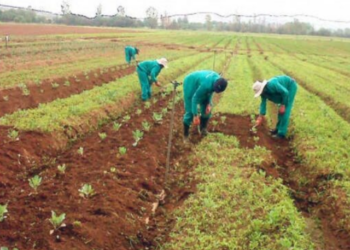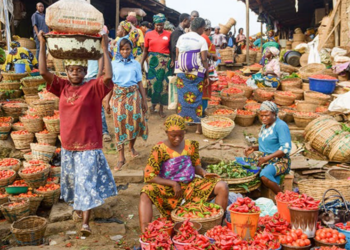In the first half of 2023, Nigeria’s dominant sectors collectively contributed N75.22 trillion, comprising 72.8% of the total non-oil sector input, marking a modest 1.6% increase compared to 2022 year-end figures of 71.2%.
This growth was primarily steered by the manufacturing sector, showing a 1.3% uptick, reaching 15.1%, along with a robust 3.4% rise in the information and communication sector, now at 14%, up from 10.6%. Construction also played a role, growing by 1.4% to reach 10.7% from 9.4%.
Conversely, agriculture faced a notable 3.7% dip, declining from 24.1% to 20.4%, while the trade sector witnessed a marginal 0.8% reduction to reach 12.5% from 13.3%.
Based on previous Nairametrics reporting, where Agriculture lead all other sectors, it remained the leading contributor to Nigeria’s nominal real GDP, despite its reduction, followed by manufacturing, information & communication, trade, and construction.
Top 5 Sectors and Their Contributions
In this report, we delve into Nigeria’s Top 5 Sectors and their contributions to H1 2023 nominal GDP
Agriculture – 20.4%:
The Agricultural sector, while still a dominant force, experienced a notable decline in H1 2023. It contributed N21.04 trillion, constituting 20.4% of the N103.35 trillion non-oil GDP for the period, marking a 3.8% drop from its 24.1% contribution in YE 2022 to 20.4%.
Within this sector, crop production played a pivotal role, accounting for N18.41 trillion or 87.5% of the total N21.04 trillion contribution in H1 2023, with this figure representing 43.1% of the N42.68 trillion generated from crop production in YE 2022.
Other subsectors made their mark as well, with livestock contributing N1.17 trillion (5.5%), forestry N196.33 billion (0.9%), and fishing N1.27 trillion (6%) to H1 2023’s agricultural GDP.
These figures also demonstrate varying levels of contribution when compared to YE 2022 data – livestock – 44.6% of N2.62 trillion, forestry – 56.3% of N196.33 billion and fishing 55.3% of N2.3 trillion.
Manufacturing – 15.1%:
In H1 2023, manufacturing emerged as the second-largest contributor to the non-oil sector’s nominal GDP, marking a 1.3% growth from YE 2022. It bolstered the economy with a total contribution of N15.63 trillion.
The Nigerian manufacturing landscape comprises 12 distinct sub-sectors, with some clear leaders. Notably, cement manufacturing, food and beverages, tobacco, textile, apparel, and footwear production stood out, collectively constituting a substantial 75.4% of the total value.
Food, beverages, and tobacco took the lead during H1 2023, contributing a significant 36.3% to the manufacturing value, amounting to N5.68 trillion.
This remarkable performance represented 60.7% of the total value generated in YE 2022, which stood at N9.36 trillion.
Following closely, the cement manufacturing subsector contributed N3.35 trillion (21.4%), with a notable share of 53.5% from the N6.26 trillion at YE 2022.
Textile, apparel, and footwear made a substantial impact as well, contributing N2.76 trillion (17.7%) to the total manufacturing value and 51.2% of the total value generated for YE 2022, which stood at N5.4 trillion.
Although other sub-sectors collectively made up 24.6% of the total manufacturing value during H1 2023, it’s noteworthy that all of them, except for oil refining, contributed over 50% of their sub-sector’s total value in YE 2022.
Information and Communication – 14%:
The information and communication sector in Nigeria showed remarkable so far during H1 2023, currently surpassing YE 2022 performance. The sector witnessed substantial growth, surging by 3.4% and contributing 14% to the nominal GDP, totaling N14.51 trillion. This represents 68.6% of the sector’s total contribution in YE 2022 of N21.15 trillion.
The telecommunications and information services sub-sector remained the driving force, contributing a commanding 83.4% to the sector’s overall performance. This substantial contribution amounted to N12.1 trillion, representing 72.1% of the total value generated in YE 2022, which stood at N16.78 trillion.
Other noteworthy sub-sectors collectively contributed 16.6% to the sector’s overall growth. Broadcasting played a pivotal role, contributing 11.1% (N1.61 trillion), which represented 58% of its YE 2022 performance of N2.75 trillion.
Motion pictures, sound recording, and music production contributed 5.4% (N777.23 billion), accounting for 49% of its value generated in YE 2022 of N1.59 trillion. Publishing contributed a minor 0.1% (N19.39 billion), representing 51.3% of its value generated in YE 2022 of N37.77 billion.
Trade – 12.5%:
Nigeria’s trade sector, of the major contributors to the Nigerian economic landscape, contributed a substantial N12.95 trillion to the nation’s nominal GDP during H1 2023, accounting for 12.5% of the total contribution. While still a significant figure, this reflects a modest 0.8% decline compared to its YE 2022 contribution of 13.3%.
H1 2023 trade activities represented 48.7% of the total value of N26.61 trillion generated in YE 2022. Importantly, Nigeria’s H1 2023 trade balance revealed total imports of N11.29 trillion and exports totalling N13.5 trillion, resulting in a balance of payments surplus of N2.22 trillion.
Examining the composition of exports, a substantial 79.5% amounting to N10.73 trillion represented crude oil exports, with the remaining 20.5% totaling N2.77 trillion attributed to non-crude oil exports. Notably, non-oil exports amounted to N1.34 trillion, constituting 48.4% of this category and contributing 9.9% to the overall export volume during H1 2023.
Construction – 10.7%:
Nigeria’s construction sector continues to be a pivotal player in the nation’s economic landscape, contributing 10.7%, equivalent to N11.1 trillion, during the first half of 2023. This growth represents a notable increase of 1.4% compared to its 9.4% contribution at YE 2022, amounting to 59.3% of the total value generated, which stood at N18.7 trillion during YE 2022.
An in-depth analysis of data from the National Bureau of Statistics (NBS) reveals a significant upsurge in the construction sector, with a current average growth rate of 39.49%. This substantial increase stands in stark contrast to the 12.72% average growth rate recorded during YE 2022.
This impressive growth can be attributed, in part, to the persistent inflationary pressures, with an H1 2023 inflation rate of 22.79%, which continues to rise, reaching 25.8% in August 2023. These economic dynamics underscore the significance of the construction sector in Nigeria’s ever-evolving economic landscape.
Other Contributors
Apart from the sectors detailed earlier, the mining and quarrying sector played a significant role, contributing 6.7% to Nigeria’s economy in the first half of 2023, whilst the remaining sectors contributed the balance 20.6% of the total value.
This contribution stands in contrast to the situation in YE 2022 when it was accompanied by real estate, contributing 6.8% and 5.1%, respectively, with all other sectors combining to make up the remaining 16.8%.















.gif)







Well done, nice information, its educative
Nice, interesting